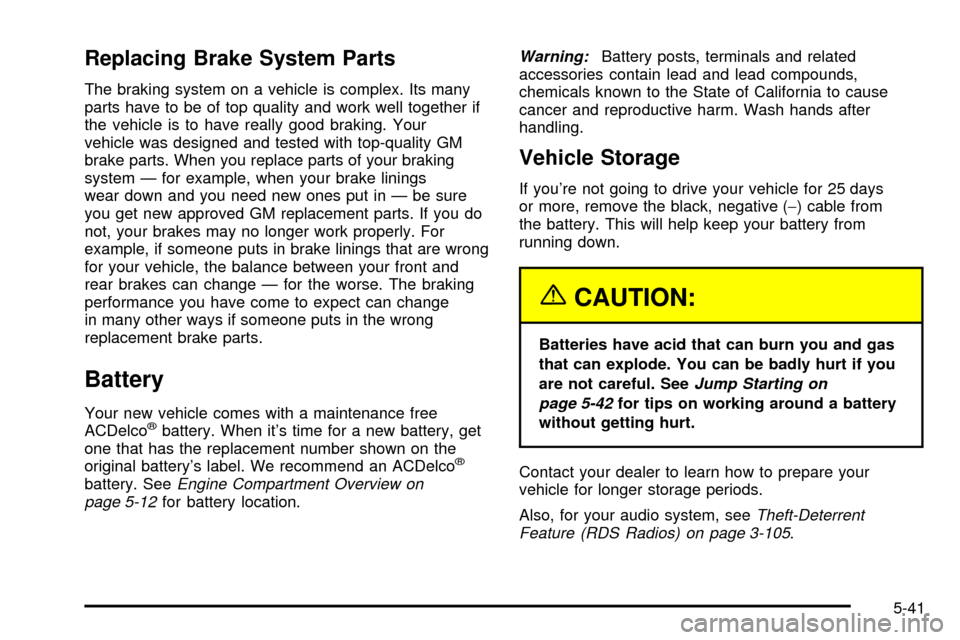2003 CHEVROLET TRAIL BLAZER warning
[x] Cancel search: warningPage 327 of 436

Replacing Brake System Parts
The braking system on a vehicle is complex. Its many
parts have to be of top quality and work well together if
the vehicle is to have really good braking. Your
vehicle was designed and tested with top-quality GM
brake parts. When you replace parts of your braking
system Ð for example, when your brake linings
wear down and you need new ones put in Ð be sure
you get new approved GM replacement parts. If you do
not, your brakes may no longer work properly. For
example, if someone puts in brake linings that are wrong
for your vehicle, the balance between your front and
rear brakes can change Ð for the worse. The braking
performance you have come to expect can change
in many other ways if someone puts in the wrong
replacement brake parts.
Battery
Your new vehicle comes with a maintenance free
ACDelcožbattery. When it's time for a new battery, get
one that has the replacement number shown on the
original battery's label. We recommend an ACDelco
ž
battery. SeeEngine Compartment Overview on
page 5-12for battery location.
Warning:Battery posts, terminals and related
accessories contain lead and lead compounds,
chemicals known to the State of California to cause
cancer and reproductive harm. Wash hands after
handling.
Vehicle Storage
If you're not going to drive your vehicle for 25 days
or more, remove the black, negative (-) cable from
the battery. This will help keep your battery from
running down.
{CAUTION:
Batteries have acid that can burn you and gas
that can explode. You can be badly hurt if you
are not careful. See
Jump Starting on
page 5-42
for tips on working around a battery
without getting hurt.
Contact your dealer to learn how to prepare your
vehicle for longer storage periods.
Also, for your audio system, see
Theft-Deterrent
Feature (RDS Radios) on page 3-105.
5-41
Page 345 of 436

Uniform Tire Quality Grading
Quality grades can be found where applicable on the
tire sidewall between tread shoulder and maximum
section width. For example:
Treadwear 200 Traction AA Temperature A
The following information relates to the system
developed by the United States National Highway
Traffic Safety Administration, which grades tires by
treadwear, traction and temperature performance.
(This applies only to vehicles sold in the United States.)
The grades are molded on the sidewalls of most
passenger car tires. The Uniform Tire Quality Grading
system does not apply to deep tread, winter-type
snow tires, space-saver or temporary use spare tires,
tires with nominal rim diameters of 10 to 12 inches
(25 to 30 cm), or to some limited-production tires.
While the tires available on General Motors passenger
cars and light trucks may vary with respect to these
grades, they must also conform to federal safety
requirements and additional General Motors Tire
Performance Criteria (TPC) standards.
Treadwear
The treadwear grade is a comparative rating based on
the wear rate of the tire when tested under controlled
conditions on a speci®ed government test course.
For example, a tire graded 150 would wear one and
a half (1.5) times as well on the government course as
a tire graded 100. The relative performance of tires
depends upon the actual conditions of their use,
however, and may depart signi®cantly from the norm
due to variations in driving habits, service practices and
differences in road characteristics and climate.
Traction ± AA, A, B, C
The traction grades, from highest to lowest, are AA, A,
B, and C. Those grades represent the tire's ability
to stop on wet pavement as measured under controlled
conditions on speci®ed government test surfaces of
asphalt and concrete. A tire marked C may have poor
traction performance. Warning: The traction grade
assigned to this tire is based on straight-ahead braking
traction tests, and does not include acceleration,
cornering, hydroplaning, or peak traction characteristics.
5-59
Page 346 of 436

Temperature ± A, B, C
The temperature grades are A (the highest), B, and C,
representing the tire's resistance to the generation
of heat and its ability to dissipate heat when tested
under controlled conditions on a speci®ed indoor
laboratory test wheel. Sustained high temperature can
cause the material of the tire to degenerate and
reduce tire life, and excessive temperature can lead to
sudden tire failure. The grade C corresponds to a
level of performance which all passenger car tires must
meet under the Federal Motor Vehicle Safety Standard
No. 109. Grades B and A represent higher levels of
performance on the laboratory test wheel than the
minimum required by law.
Warning: The temperature grade for this tire is
established for a tire that is properly in¯ated and not
overloaded. Excessive speed, underin¯ation, or
excessive loading, either separately or in combination,
can cause heat buildup and possible tire failure.
Wheel Alignment and Tire Balance
The wheels on your vehicle were aligned and balanced
carefully at the factory to give you the longest tire life
and best overall performance.
Scheduled wheel alignment and wheel balancing are
not needed. However, if you notice unusual tire wear or
your vehicle pulling one way or the other, the alignment
may need to be reset. If you notice your vehicle
vibrating when driving on a smooth road, your wheels
may need to be rebalanced.
5-60
Page 350 of 436

Changing a Flat Tire
If a tire goes ¯at, avoid further tire and wheel damage
by driving slowly to a level place. Turn on your
hazard warning ¯ashers.
{CAUTION:
Changing a tire can cause an injury. The
vehicle can slip off the jack and roll over you
or other people. You and they could be badly
injured. Find a level place to change your tire.
To help prevent the vehicle from moving:
1. Set the parking brake ®rmly.
2. Put the shift lever in PARK (P).
3. If you have a four-wheel-drive vehicle,
be sure the transfer case is in a drive
gear ± not in NEUTRAL.
4. Turn off the engine.
5. Put the wheel blocks at the front and rear
of the tire farthest away from the one
being changed. That would be the tire on
the other side of the vehicle, at the
opposite end.The following steps will tell you how to use the jack and
change a tire.
5-64
Page 365 of 436

Appearance Care
Remember, cleaning products can be hazardous. Some
are toxic. Others can burst into ¯ames if you strike a
match or get them on a hot part of the vehicle. Some are
dangerous if you breathe their fumes in a closed
space. When you use anything from a container to clean
your vehicle, be sure to follow the manufacturer's
warnings and instructions. And always open your doors
or windows when you are cleaning the inside.
Never use these to clean your vehicle:
·Gasoline
·Benzene
·Naphtha
·Carbon Tetrachloride
·Acetone
·Paint Thinner
·Turpentine
·Lacquer Thinner
·Nail Polish Remover
They can all be hazardous Ð some more than
others Ð and they can all damage your vehicle, too.Do not use any of these unless this manual says you
can. In many uses, these will damage your vehicle:
·Alcohol
·Laundry Soap
·Bleach
·Reducing Agents
Cleaning the Inside of Your Vehicle
Use a vacuum cleaner often to get rid of dust and
loose dirt. Wipe vinyl, leather, plastic and painted
surfaces with a clean, damp cloth.
Cleaning Fabric/Carpet
Your dealer has cleaners for the cleaning of fabric
and carpet. They will clean normal spots and stains
very well.
You can get GM-approved cleaning products from your
dealer. See
Vehicle Care/Appearance Materials on
page 5-86.
5-79
Page 421 of 436

A
Accessory Power Outlets.................................3-20
Adding a Snow Plow or Similar Equipment.........4-50
Adding Washer Fluid.......................................5-37
Additional Program Information........................... 7-8
Additives, Fuel................................................. 5-6
Add-On Electrical Equipment............................5-88
Adjusting the Speakers
(Balance/Fade)............................3-67, 3-75, 3-84
After Off-Road Driving.....................................4-28
Air Bag Systems.............................................1-49
How Does an Air Bag Restrain?....................1-56
Servicing Your Air Bag-Equipped Vehicle.........1-59
What Makes an Air Bag In¯ate?....................1-56
What Will You See After an Air
Bag In¯ates?...........................................1-57
When Should an Air Bag In¯ate?...................1-55
Where Are the Air Bags?..............................1-52
Air Bag .........................................................3-38
Readiness Light..........................................3-38
Air Cleaner/Filter, Engine.................................5-20
AM .............................................................3-106
Antenna, Fixed Mast......................................3-108
Anti-Lock Brake, System Warning Light..............3-42
Anti-lock Brake System..................................... 4-7
Appearance Care............................................5-79
Care of Safety Belts....................................5-82
Chemical Paint Spotting...............................5-85
Cleaning the Inside of Your Vehicle................5-79Appearance Care (cont.)
Cleaning the Outside of Your Vehicle..............5-82
Finish Damage............................................5-85
Sheet Metal Damage...................................5-84
Underbody Maintenance...............................5-85
Vehicle Care/Appearance Materials................5-86
Weatherstrips..............................................5-82
Approaching a Hill..........................................4-20
Ashtrays........................................................3-20
Audio Speakers..............................................3-94
Audio System(s).............................................3-64
Audio Steering Wheel Controls....................3-106
Care of Your Cassette Tape Player...............3-107
Care of Your CD and DVD Player................3-108
Care of Your CDs and DVDs.......................3-108
Chime Level Adjustment.............................3-108
Fixed Mast Antenna...................................3-108
Audio Systems..............................................3-105
Radio Personalization.................................3-105
Audio System(s).............................................3-72
Radio with Cassette and CD.........................3-72
Radio with CD............................................3-65
Radio with Six-Disc CD................................3-82
Rear Seat Audio (RSA)...............................3-104
Setting the Time..........................................3-64
Theft-Deterrent Feature...............................3-105
Understanding Radio Reception...................3-106
Automatic Headlamp System............................3-16
Automatic Transfer Case..................................2-25
Automatic Transmission Check..........................6-12
1
Page 422 of 436

Automatic Transmission Shift Lock Control
System Check.............................................6-14
Automatic Transmission...................................5-22
Fluid..........................................................5-22
Operation...................................................2-22
B
Backglass Wiper Blade Replacement.................5-53
Backing Up....................................................4-57
BATTERY NOT CHARGING.............................3-61
Battery Replacement......................................... 2-7
Battery Run-Down Protection............................3-19
Battery..........................................................5-41
Before Leaving on a Long Trip.........................4-35
Before You Drive............................................3-93
Before You Go Off-Roading..............................4-16
Body Lubrication Service..................................6-13
Brake Adjustment............................................5-40
Brake Fluid....................................................5-38
Brake Pedal Travel.........................................5-40
Brake Wear...................................................5-40
Brake............................................................2-28
Parking......................................................2-28
System Inspection.......................................6-17
System Warning Light..................................3-41
Brakes..........................................................5-38
Braking in Emergencies..................................... 4-8
Braking........................................................... 4-6Break-In, New Vehicle.....................................2-18
Bulb Replacement...........................................5-50
Replacement Bulbs......................................5-51
Taillamps and Turn Signal Lamps..................5-50
Buying New Tires...........................................5-58
C
California Fuel.................................................. 5-5
Canada ± Customer Assistance.......................... 7-4
Canadian Owners................................................ ii
Canadian Roadside Assistance........................... 7-6
Capacities and Speci®cations..........................5-100
Carbon Monoxide...................4-38, 4-50, 2-13, 2-32
Care of.........................................................5-82
Safety Belts................................................5-82
Your Cassette Tape Player..........................3-107
Your CD and DVD Player...........................3-108
Your CDs and DVDs..................................3-108
Cargo Cover..................................................2-49
Cargo Tie Downs............................................2-50
Cassette Tape Messages.................................3-79
Cassette Tape Player Service...........................6-11
Chains, Tires..................................................5-62
Charging System Light....................................3-39
Check...........................................................3-43
Engine Light...............................................3-43
Gages Warning Light...................................3-49
CHECK WASHER FLUID.................................3-62
2
Page 424 of 436

Cruise Control................................................3-12
Current and Past Model Order Forms................7-10
Customer Assistance Information........................ 7-7
Courtesy Transportation.................................. 7-7
Customer Assistance for Text
Telephone (TTY) Users............................... 7-4
Customer Assistance Offices........................... 7-4
Customer Satisfaction Procedure..................... 7-2
GM Mobility Program for Persons with
Disabilities................................................ 7-5
Reporting Safety Defects to General Motors...... 7-9
Reporting Safety Defects to the Canadian
Government.............................................. 7-9
Reporting Safety Defects to the United
States Government.................................... 7-8
Roadside Assistance Program......................... 7-5
Service Publications Ordering Information......... 7-9
D
Daytime Running Lamps (DRL).........................3-17
Defensive Driving............................................. 4-2
Defogging and Defrosting.........................3-22, 3-28
Delayed Locking............................................... 2-9
Dinghy Towing................................................4-45
Doing Your Own Service Work........................... 5-3
Dolly Towing..................................................4-47
Dome Lamp Override......................................3-18
Dome Lamps.................................................3-19Door............................................................... 2-9
Delayed Locking........................................... 2-9
Locks.......................................................... 2-8
Power Door Locks......................................... 2-9
Programmable Automatic Door Locks.............2-10
Rear Door Security Locks.............................2-12
DRIVER DOOR AJAR.....................................3-63
Driver Information Center (DIC).........................3-51
DIC Operation and Displays..........................3-52
DIC Warnings and Messages........................3-61
Driver............................................................1-14
Position, Safety Belt.....................................1-14
Driving Across an Incline..................................4-25
Driving Downhill..............................................4-23
Driving in Mud, Sand, Snow or Ice....................4-27
Driving in Water..............................................4-28
Driving On Grades..........................................4-58
Driving on Off-Road Hills.................................4-19
Driving on Snow or Ice....................................4-38
Driving Through Deep Standing Water...............4-32
Driving Through Flowing Water.........................4-32
Driving Uphill..................................................4-21
Driving with a Trailer.......................................4-56
Driving..........................................................4-29
At Night.....................................................4-29
City...........................................................4-33
Defensive..................................................... 4-2
Drunken....................................................... 4-2
Freeway.....................................................4-34
Hill and Mountain Roads..............................4-36
4